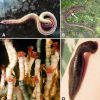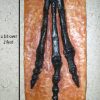calsfoundation@cals.org
Pirate Perch
The pirate perch (Aphredoderus sayanus) belongs to the order Aphredoderiformes (or by some sources, Percopsiformes) and family Aphredoderidae. There are two subspecies, A. s. sayanus and A. s. gibbosus. It is the only living member of the family and ranges from the Atlantic and Gulf slopes from Michigan, Wisconsin, Minnesota, and New York south to the Gulf of Mexico and west to the Brazos River drainage, Texas. In Arkansas, A. sayanus occurs throughout the Coastal Plain physiographic region extending westward into the central areas of the state. It is quite rare in the Ozark uplands, and there are no records from the northwestern part of the state.
The Aphredoderidae contains one fossil genus, Trichophanes, with possibly two of three valid species described. The fossil record of A. sayanus indicates that the family once had a much wider North American distribution in the Oligocene (34 to 23 million years ago) and Miocene (23 to 5.3 million years ago) epochs. The pirate perch is most closely related (remotely) to the trout-perches (Percopsidae) and cavefishes (Amblyopsidae). It was described by J. Gilliams in 1824 as Scolopsis sayanus from near Philadelphia, Pennsylvania. The specific name sayanus is a patronym honoring the famous naturalist Thomas Say (1787‒1834). Charles C. Abbott (1843‒1919) gave the fish its common name after observing a captive specimen eating only other fishes in an aquarium, and for its perch-like appearance. This odd little fish, up to 14 centimeters (5.5 inches) in total length, is normally solitary, carnivorous, and a nocturnal feeder, with peak activity at dusk and dawn. It is known to consume a variety of prey, including amphipods, cladocerans, earthworms, isopods, glass shrimp, mealworms, mosquito larvae, dragonfly and stonefly larvae, and small fish.
This freshwater fish commonly inhabits coastal waters along the east coast of the United States and backwater areas of the Mississippi River Valley. It is found most often near the bottom of clear, warm water habitats with little to no current, including bottomland lakes, overflow ponds, oxbows, and quiet pools and backwaters of slow-moving streams and ditches. It also inhabits areas with both clear and turbid water with dense cover consisting of aquatic plants or organic debris over soft mud and silt bottoms.
Body coloration of A. sayanus varies, but it is generally a slate gray to black with pink to iridescent purple laterally; sometimes, there is a darker band near the base of the slightly notched caudal fin. A unique feature of this fish is the forward placement (migration) of its urogenital openings and anus (cloaca), under the head near the jugular (throat) region, just anterior to the pelvic fins in adults. In young, however, the anus lies just in front of the anal fin but migrates to the throat during maturity. The mouth is large, the body scales are small and strongly ctenoid, the lateral line is incomplete or absent, there is a single dorsal fin with ten to eleven dorsal fin rays and three spines, the pelvic fin has six rays and one spine, and the anal fin has six to seven rays with two to three spines.
Reproduction in pirate perch occurs from May to early June in Arkansas. When breeding, female pirate perch seek underwater root masses as the microhabitat to deposit their eggs, which are then fertilized by the male. A unique spawning behavior has been noted, which has been referred to as transbranchioral (“through the gill chamber”). Once the eggs are laid, they are transferred directly from the urogenital to the gill chamber and then spat out through the mouth into the substrate. It is also believed that a nest is constructed and guarded by both parents until the eggs hatch and the fry reach several centimeters in length. Depending on body size, females can lay between 100 and 400 eggs. Pirate perch are able to reproduce at one year old and have a lifespan of about four years. Having the anus located far forward is an adaptation to allow for the easy transfer of eggs from the anus to the mouth. It is thought that the eggs are incubated in the female pirate perch’s gill cavities in a manner similar to Amblyopsis cavefishes. The pirate perch has been reported to not brood bronchially.
Several parasites have been reported from A. sayanus. In Oklahoma, parasitological surveys of pirate perch have reported trematodes, and in Arkansas acanthocephalans were reported from A. sayanus from the Caddo River (Clark County) and Rolling Fork River (Sevier County), respectively. In addition, a proteocephalan tapeworm was found in pirate perches from a spring-fed stream near Cushman (Independence County).
For additional information:
Bailey, Reeve M., H. E. Winn, and C. L. Smith. “Fishes of the Escambia River, Alabama and Florida, With Ecologic and Taxonomic Notes.” Occasional Papers of the Museum of Zoology, University of Michigan 683 (1954): 1‒21.
Blatchley, W. S. “On the Genus Aphredoderus.” Proceedings of the Academy of Natural Sciences of Philadelphia 37 (1885): 136–137.
Boltz, J. M., and Jay R. Stauffer Jr. “Branchial Brooding in the Pirate Perch, Aphredoderus sayanus (Gilliams).” Copeia 1986 (1986): 1030–1031.
———. “Systematics of Aphredoderus sayanus (Teleostei: Aphredoderidae).” Copeia 1993 (1993): 81–98.
Buchanan, Thomas M., Drew Wilson, L. G. Claybrook, and William G. Layher. “Fishes of the Red River in Arkansas.” Journal of the Arkansas Academy of Science 57 (2003): 18‒26. Online at: https://scholarworks.uark.edu/jaas/vol57/iss1/5/ (accessed September 16, 2021).
Douglas, Neil H. Freshwater Fishes of Louisiana. Baton Rouge: Claitor’s Publication Division, 1974.
Elkins, C. A., and Kenneth C. Corkum. “Growth Dynamics and Seasonal Prevalence of Crepidostomum isostomum and Phyllodistomum pearsei in Aphredoderus sayanus.” Journal of Wildlife Diseases 12 (1976): 208‒214.
Etnier, David A., and Wayne C. Starnes. The Fishes of Tennessee. Knoxville: University of Tennessee Press, 1993.
Fletcher, D. E., E. E. Dakin, B. A. Porter, and John C. Avise. “Spawning Behavior and Genetic Parentage in the Pirate Perch (Aphredoderus sayanus), a Fish with an Enigmatic Reproductive Morphology.” Copeia 2004 (2004): 1–10.
Fontenot, Q. C., and D. A. Rutherford. “Observations on the Reproductive Ecology of Pirate Perch Aphredoderus sayanus.” Journal of Freshwater Ecology 14 (1999): 545–549.
Gilliams, J. “Description of a New Species of Fish of the Linnean Genus Perca.” Journal of the Academy of Natural Sciences of Philadelphia 4 (1824): 80–82.
Hall, G. E., and Robert M. Jenkins. “Notes on the Age and Growth of the Pirate Perch, Aphredoderus sayanus, in Oklahoma.” Copeia 1954 (1954): 69.
Hoffman, Glenn L. Parasites of North American Freshwater Fishes. 2nd ed. Berkeley: University of California Press, 2009.
Lee, David S. “Aphredoderus sayanus (Pirate Perch).” In Atlas of North American Freshwater Fishes, edited by David S. Lee, et al. Raleigh: North Carolina State Museum of Natural History, 1980.
McAllister, Chris, and Omar Amin. “Acanthocephalan Parasites (Echinorhynchida: Heteracanthocephalidae; Pomphorhynchidae) from the Pirate Perch (Percopsiformes: Aphredoderidae), from the Caddo River, Arkansas.” Journal of the Arkansas Academy of Science 62 (2008): 151‒152. Online at https://scholarworks.uark.edu/jaas/vol62/iss1/26/ (accessed September 16, 2021).
McAllister, Chris T., and Charles R. Bursey. “Noteworthy Trematode (Digenea) Parasites of the Pirate Perch, Apherododerus sayanus (Percopsiformes: Aphredoderidae), from Southeastern Oklahoma.” Proceedings of the Oklahoma Academy of Science 93 (2013): 37-40.
McAllister, Chris T., Charles R. Bursey, and Henry W. Robison. “Proteocephalus pearsei (Cestoidea: Proteocephalidae) from the Pirate Perch, Aphredoderus sayanus (Percopsiformes: Aphredoderidae), in Northern Arkansas, U.S.A.” Comparative Parasitology 79 (2012): 344‒347.
McAllister, Chris T., Charles R. Bursey, Henry W. Robison, David A. Neely, Matthew B. Connior, and Michael A. Barger. “Miscellaneous Fish Helminth Parasite (Trematoda, Cestoidea, Nematoda, Acanthocephala) Records for Arkansas.” Journal of the Arkansas Academy of Science 68 (2014): 78‒86. Online at https://scholarworks.uark.edu/jaas/vol68/iss1/14/ (accessed September 16, 2021).
McCallum, Malcolm L. “Notes on the Diet and Egg Clutches of the Pirate Perch (Aphredoderus sayanus) from Central Arkansas.” Southeastern Naturalist 11 (2012): 543‒545.
Miller, Rudolph J., and Henry W. Robison. Fishes of Oklahoma. Norman: University of Oklahoma Press, 2004.
Page, Larry M., and Brooks M. Burr. Peterson Field Guide to Freshwater Fishes of North America North of Mexico. 2nd ed. Boston: Houghton Mifflin Harcourt, 2011.
Pflieger, William L. The Fishes of Missouri. Jefferson City: Missouri Department of Conservation, 1997.
Robison, Henry W., and Thomas M. Buchanan. Fishes of Arkansas. 2nd ed. Fayetteville: University of Arkansas Press, 2020.
Ross, Stephen T. The Inland Fishes of Mississippi. Jackson: University Press of Mississippi, 2001.
Chris T. McAllister
Eastern Oklahoma State College
 Annelids
Annelids Science and Technology
Science and Technology Pirate Perch
Pirate Perch 



Comments
No comments on this entry yet.